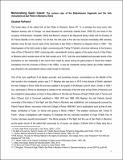Memorialising Gaelic Ireland: the curious case of the Ballyshannon fragments and the Irish monuments at San Pietro in Montorio, Rome
Date
2010Author
FitzPatrick, Elizabeth
Metadata
Show full item recordUsage
This item's downloads: 167 (view details)
Recommended Citation
FitzPatrick, Elizabeth (2010). Memorialising Gaelic Ireland: the curious case of the Ballyshannon fragments and the Irish monuments at San Pietro in Montorio, Rome. In D. Finnegan, M.C. Harrigan, & E Ó Ciardha (Eds.), Imeacht na n-Iarlaí Derry: Guildhall Press.
Published Version
Abstract
The burial place of the exiled Irish at San Pietro in Montorio, Rome (Pl. 1), is perhaps the most iconic Irish
diaspora funerary site in Europe, not least because the community interred there (1608–23) are found in the
company of Bramante’s Tempietto (1502) and Bernini’s chapel to the Raymondi family (1640) with his Ecstasy of
St Francis Baratta on the reredos. For all that, the Irish past at the site has received remarkably little scholarly
attention since the last record made of the memorials at San Pietro in Montorio by Gasparo Alveri in 1664.1 The
historiography of the Irish burials is slight, commencing with Tadhg Ó Cianáin’s chronicle reference to the funerary
rites of Rory O’Donnell in 1608,
2 continuing with a seventeenth-century registry of the parish church of San Pietro
in Montorio which records some of the Irish burials up to 1613,
3 with the most detailed and accurate record of the
inscriptions on the memorials in the church floor made by Alveri during his great project to record the modern
inscriptions from the churches of Rome in the 1660s. It was the nineteenth century before any further attention
was directed to the seventeenth-century exiles buried on Gianicolo.


